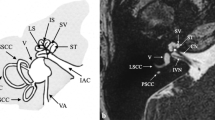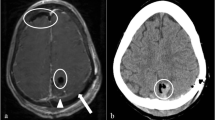Abstract
Occult malformations of the skull base are rare anomalies, but can cause severe complications such as meningitis. Detailed skull base investigations for detecting cerebrospinal fluid fistulas or celes are often not initiated until after a history of recurrent meningitis. We present a child first seen at the age of 12 with recurrent episodes of bacterial meningitis since early childhood, requiring antibiotic prophylaxis for years. High-resolution computed tomography revealed a chronic sinusitis and a bony defect on the right olfactory groove, while magnetic resonance imaging and CT-cisternography indicated no cerebrospinal fluid fistula or cele at that time. Endonasal surgery for chronic sinusitis was performed with a confirmed bony defect on the right olfactory groove and an olfactory fibre without its sleeve-like dura prolongation running into an adjacent ethmoidal cell, necessitating that it be covered. In the absence of any antibiotics a new episode of meningitis occurred 5 years after surgery. CT-cisternography and magnetic resonance imaging were repeated, now indicating a transclival bony defect with a meningocele in its proximal part, most probably presenting a canalis basilaris medianus. Endonasal surgery confirmed this bony defect after adenoidectomy, and closure was accomplished. No further meningitis has been observed for 2 years. Congenital skull base defects may be difficult to detect, but sufficient surgical closure after their precise delineation is mandatory to prevent infectious endocranial complications. The presence of more than one developmental skull base defect should be considered during careful radiological skull base evaluation, which has to include the clivus in order not to overlook rare basilar malformations.




Similar content being viewed by others
References
Anderson T (2000) Basilar clefting: a familial condition? Ann Anat 182: 583–587
Carrol ED, Latif AH, Misbah SA, Flood TJ, Abinun M, Clark JE, Pugh RE, Cant AJ (2001) Recurrent bacterial meningitis: the need for sensitive imaging. BMJ 323: 501–503
Currarino G (1988) Canalis basilaris medianus and related defects of the basiocciput. AJNR 9: 208–211
Fiegler W (1980) Der Canalis basilaris medianus im Röntgenbild und Computertomogramm. ROFO Fortschr Geb Rontgenstr Nuklearmed 133: 416–419
Gruber W (1880) Über den anomalen Canalis basilaris medianus des Os occipitale beim Menschen. Mém Acad Imp Sci St. Petersburg sér VII, tome 27, no 9
Hemphill M, Freeman JM, Martinez CR, Nager GT, Long DM, Crumrine P (1982) A new, treatable source of recurrent meningitis: basioccipital meningocele. Pediatrics 70: 941–943
Jacquemin C, Bosley TM, al Saleh M, Mullaney P (2000) Canalis basilaris medianus: MRI. Neuroradiology 42: 121–123
Lang J (1979) Praktische Anatomie. In: Lang J, Wachsmuth W (eds), Band I/1, Teil B. Springer Berlin New York Heidelberg
Le Double AF (1903) Traité des variations des os du crane de l`homme et de leur signification au point de vue de l`anthropologie zoologique. Vigot, Paris
Martinez CR, Hemphill JM, Hodges FJ, Gayler BW, Nager GT, Long DM, Freeman JM (1981) Basioccipital meningocele. AJNR 2: 100–102
Oehmke HJ (1963) Die Bedeutung des Canalis basilaris und seine Darstellung im Röntgenbild. Gegenbaurs Morphol Jahrb 104: 459–475
Perna G (1906) Sul canale basilare mediano e sul significato della fossetta faringea dell`osso occipitale. Anat Anz 28: 379–392
Richter E, Pirsig W, Tänzer A (1975) Offener Canalis cranio-pharyngeus mit spheno-pharyngealer Meningoenzephalozele. HNO 23: 240–245
Sauser G (1933) Manifestation der Occipitalplatte an einem menschlichen Schädel. Zs Anat Entwicklungsgesch 102: 51–56
Schick B, Draf W, Kahle G, Weber R, Wallenfang T (1997a) Occult malformations of the skull base. Arch Otolaryngol Head Neck Surg 123: 77–80
Schick B, Weber R, Kahle G, Draf W, Lackmann GM (1997b) Late manifestations of traumatic lesions of the anterior skull base. Skull Base 7: 77–83
Schick B, Brors D, Prescher A (2000) Sternberg's canal—cause of congenital sphenoidal meningocele. Eur Arch Otorhinolaryngol 257: 430–432
Von Torklus D, Gehle W (1972) Die obere Haslwirbelsäule. 2 Aufl. Thieme, Stuttgart
Wolf G, Greistorfer K, Stammberger H (1997) Endoscopic detection of cerebrospinal fluid fistulas with a fluorescence technique. Report of experiences with over 925 cases. Laryng Rhino Otol 76: 588–594
Author information
Authors and Affiliations
Corresponding author
Rights and permissions
About this article
Cite this article
Schick, B., Prescher, A., Hofmann, E. et al. Two occult skull base malformations causing recurrent meningitis in a child: a case report. Eur Arch Otorhinolaryngol 260, 518–521 (2003). https://doi.org/10.1007/s00405-003-0620-0
Received:
Accepted:
Published:
Issue Date:
DOI: https://doi.org/10.1007/s00405-003-0620-0




